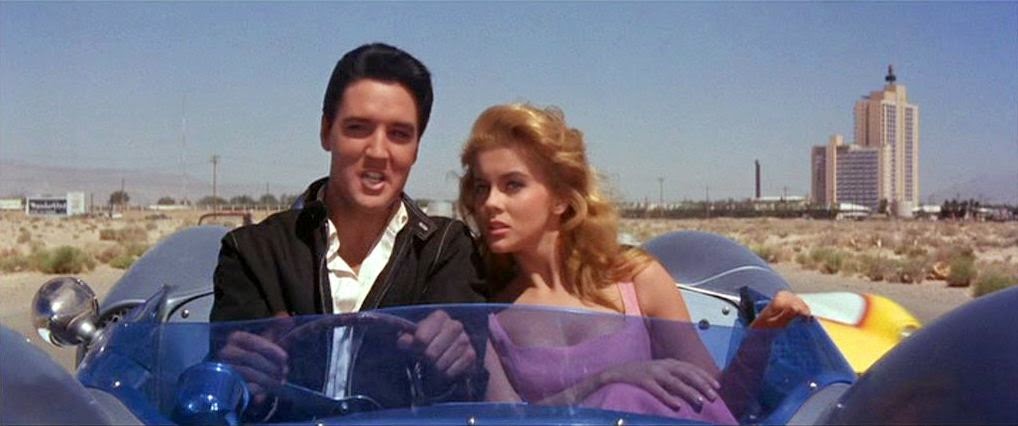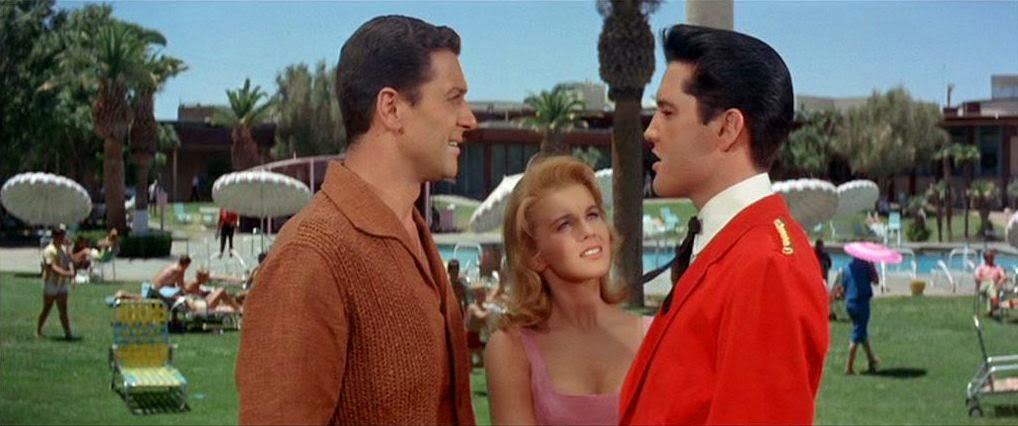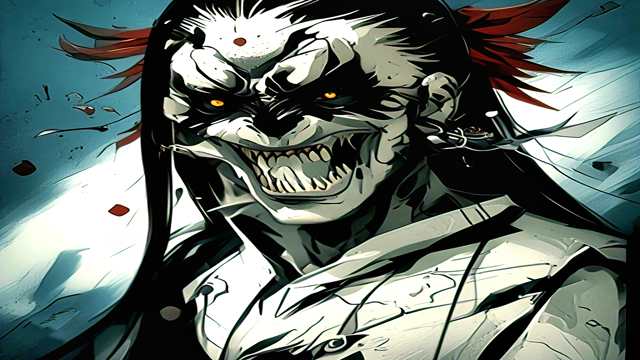
Elvis Presley was the direct heir to Frank Sinatra as epoch-defining music star and heartthrob, armed with a new type of music and a far more aggressively suave persona. Both men readily incorporated their poor-boy-made-good status as part of their mystique, but whereas Sinatra settled into ambassador for jet-age class, Presley’s edge of the uncouth remained a powerful weapon even as he slicked up and shipped out. Both men also had very successful film acting careers. As a movie star, though, Presley never got a real chance to follow in Sinatra’s post-From Here to Eternity (1953) footsteps and attain thespian credibility. Apart from some of his earlier, more classically dramatic vehicles like Jailhouse Rock (1957), Kid Creole (1958), and Kid Galahad (1962), Presley’s movies are usually dismissed as goofy balls of kitsch, up-market editions of the Beach Party films that made giant piles of money at the cost of slowly destroying the credibility of the once-untamed, inimitable rock star. There is a lot of truth to this. When he did try and break out of his musical comedy trap, with Charro!and Change of Habit (both 1969), the results were too late and too weakly received to help, and Elvis subsequently stuck to reviving his music career. Viva Las Vegas, one of his frothiest, silliest, most utterly lightweight films, nonetheless belies this narrative, to the extent that it testifies to the power of total nonsense as a cinematic value. Viva Las Vegas is as pure a star vehicle as any movie has ever been, a work that exists as a cinematic unit purely to exhibit the pleasures of watching Elvis and co-star Ann-Margret on screen, a film that caters to the desire of the audience to just spend time hanging out with beautiful, talented people.

There is a vestige of a plot, and the characters have names that are not Elvis and Ann-Margret, but that doesn’t fool anyone. The director, George Sidney, was an old hand with flashy Technicolor musicals like Anchors Away (1944), Kiss Me Kate (1953), and Pal Joey (1957), although he’d dipped his toe successfully into action-adventure fare with Scaramouche (1951), where he played up the theatricality of the piece, making it a testimonial to role-playing and the spectacle of movement, and much less successfully with The Three Musketeers (1948), where the egregiously bright colour-coding of the heroes nonetheless clearly anticipates the obsessions exhibited in Viva Las Vegas with costuming and décor. Viva Las Vegas sprawls like an illustrated page from an old Japanese scroll, in widescreen swathes of colour broken into variegated patches, amidst which the faces of Elvis and Ann-Margret bob. Sidney had boosted Ann-Margret to stardom with that famous opening to the otherwise insufferable Bye Bye Birdie (1963), where she played a love-struck teen crushing on an Elvis-esque character. Some genius had the idea of actually placing her opposite the real thing just to see what would happen. But rather than have her play a girl chasing the man, this time Sidney and screenwriter Sally Benson, knowing full well what a fireball the actress could be, made her force unto herself. This gave Elvis something he too rarely encountered: an equal.

Elvis’s ‘60s films might even be described as the American answer to the James Bond films of the same era. Both series, after all, offer their hero as fantasy avatar cutting a path through high-life beauties and living carelessly on the edge, hence Elvis’ common on-screen job as a racing driver. Here he’s Lucky Jackson, intending to enter the Las Vegas Grand Prix and planning to buy a super-fast engine for his car, built by his mechanic pal Shorty Farnsworth (Nicky Blair). Shorty speeds from LA to Vegas to warn Lucky he’d better buy the motor fast, because his boss might just sell it to another racer. Lucky maintains a friendly rivalry for Rusty’s attention with his fellow race driver Count Elmo Mancini (Cesare Danova). The trio – I hesitate to say threesome, but damn, the film does everything but throw the bunch of them in the sack together Jules et Jim style – meet at the garage where the racers prime their vehicles, with Rusty pulling in and, mistaking the Count and the King for humble mechanics, asking them to check out her motor, setting in motion their frantic, panicky boyish efforts to please this lawless short-shorted babe. The two men cruise the Las Vegas scene in search of their prize, assuming her to be a dancer, and have to negotiate such difficulties as how to clear out a crowd of blitzed Texans out of a bar – a jokey sequence that revolves around Presley’s reflexive ability to speak the many parts of American culture on their own level. Soon Lucky finds Rusty is actually the manager of the pool of his hotel, a discovery that results in him losing all his cash as he flirts with her. Lucky is forced to pay off his hotel bill with Shorty, working as waiters.

The comedy in Viva Las Vegas is sometimes just dumb enough to be funny and sometimes just dumb, following the same make-it-up-as-we-go logic as early Marx Brothers movies, as Lucky and Shorty roll with the punches. The Marxist flavour is particularly strong when Lucky sets out to wreck Mancini’s seductive tête-à-tête with Rusty by making himself their dinner attendant and making a proper hash of it. The plot is a scant variation on one of those Maurice Chevalier-woos-Jeanette Macdonald vehicles from the early ‘30s where the footloose guy falls for the obviously smitten lady, but she spurns him in a dance of attraction and rejection for a suitable amount of the running time, with a little rivalry from a higher-class suitor. Something like complication is provided by Rusty’s anxiety over Lucky’s occupation as the dangerousness of car racing is made plain to her, and he resists her attempts to bring him to heel. Rusty’s father (William Demarest) has a far more sedate job, sailing tourists about on Lake Mead, but he’s secretly thrilled by Lucky’s business, enough to lend Shorty the money to buy the car motor in time to make the big race. In the meantime Lucky and Rusty go head-to-head in competition by entering the hotel’s talent contest, each hoping to net the prize, which proves to be disappointing for both – so close are the levels of applause each receives from the crowd that the MC flips a coin to decide who wins, with Rusty capturing a pool table and Lucky a prepaid honeymoon. This is all a very thin scarecrow to hang many scenes of Presley, Ann-Margret, and sometimes the dashing Danova interacting, and the film is at its best, unsurprisingly, when musical. Sidney’s capacity to capture sexual chemistry is the real octane firing the film’s motor, as it was with his hypnotic delight in another redhead, Eleanor Parker, rattling Stewart Granger’s cage on Scaramouche.

Whether or not the on-set affair between Presley and Ann-Margret was all it was cracked up to be, what’s plain is the spectacle of the pair getting off on each-other throughout Viva Las Vegas, to a degree that’s almost like watching fully-clothed pornography. The pleasure of attraction is stoked all the hotter by the constant, vibrant, happy competition and mutual enjoyment that’s apparent in the film’s many performing scenes. Viva Las Vegas, through its sheer defiant belief in surface pleasures, can be called a relic of the then-burgeoning pop art movement. Sidney films in rectilinear framings that all but place a MOMA bracket around the action, tracking Ann-Margret and dancers up and down a stage in pure motion study (recalling Godard’s similar camera movement tracking the more sarcastic stage performance in Le Mepris, 1963, as if retorting to cynical amateurism with the real deal). Lines of showgirls and the sprawling billboards of America’s playgrounds are conflated, bright lights of the big city to set the sensual consumerist’s soul on fire. Viva Las Vegas was an immediate influence on the Japanese anime show Speed Racer, and indeed the film has a kind of gaudy, day-glo expanse that readily calls animation to mind, and also, weirdly, reminded me of Seijun Suzuki’s squared-off, hyper-coloured compositions on Tokyo Drifter (1966). The lustre of the candy-hued visual design certainly might have influenced Jacques Demy’s The Young Girls of Rochefort (1967). Sidney shoots Presley and Ann-Margret having a ball amidst a cotillion of hopped-up squares caught in the blast radius of the new Dionysianism, twisting and shouting on a spinning stage, the sinuous flirtation of George McFadden and The Jordanaires “The Climb” segueing into Presley covering the full-on musical bacchanalia of Ray Charles’ “What’d I Say.”

Elvis is forced to primly tone down the orgasmic thunder in the call-and-response part of the song, but Sidney zeroes in for rapid edits alternating between his and Ann-Margret’s faces as they gasp “Ah! Oh!” at each-other, film language filling in for erotic furore. Presley’s Cerberus Col. Tom Parker fought noisily with Sidney on set because he saw that Sidney was executing MGM’s plot to render the film into a star-making vehicle for Ann-Margret using Presley in part as a prop to make her exciting. This is readily apparent in the talent show scene. Presley breaks out the title song, the most memorable new song on the film’s soundtrack and destined to be one of the singer’s most readily recognisable staples. And yet the staging of the performance, shooting Presley cavorting with some listless, half-naked showgirls in a single fluid shot, makes Elvis look almost stodgy in following Ann-Margret’s production number, which goes all out to announce her as a great talent, the classic triple threat, able to play both hip sex kitten and old-fashioned glamour-puss. There’s even a sequence where Ann-Margret takes on Elvis at a bunch of boy things and beats him, from skeet shooting to motorcycle riding to fake cowboy gunfights, priming the age of women’s lib. The effect is undeniable: Ann-Margret seems by film’s end to be set as a new atom bomb of musical movies, just in time for the near-death of that mode of moviemaking.

Ann-Margret’s dramatic gifts were still developing, and some of her line readings hit the ear as frail. But she’s always a grand screen presence, alight with a sass and sexual imperiousness on screen that still puts a lot of would-be heirs to shame, and her joy in sheer physical dexterity is infectious, to the point where she’s fun to watch even when doing some silly comic business, as when she tries to plug in a coffee maker in the midst of the busy drivers’ garage. The air of a professional lothario’s pomposity that would begin to dog Presley within a few years in his movies was still being held at bay by his naturalness on screen, a boyish streak of glee behind the playboy affectations, although aspects of his nose-flaring, lip-sneering act were starting to look like a form of kabuki already. Still, it’s a testimony to Presley’s unshakeable aura of masculinity that he can spend as much of the film being humiliated or emasculated in some way, to a degree that only Cary Grant before him allowed (see I Was a Male War Bride, 1949), and still seem like the best of sports. The film’s cool-down moment, a solitary song Elvis performs when pining for his lady in the waned hours of Vegas nightlife, “I Need Somebody to Lean On,” sounds a little like Sinatra’s “One For My Baby,” and for a moment Presley gains the brand of emotionally supple strength the elder star wielded and genuinely begs the question what kind of tragedian he might have made. The film remembers to throw in the long-promised big race as afterthought finale, a procession of party-coloured cars zipping across the parched expanses of Sidney’s desertscapes. Mancini gets into a godawful pile-up, whilst Lucky drives on with a slight gasp of chagrin. Lucky gets right back to business, winning through Elvis’s astonishing mastery of the power of back projection. Fortunately Mancini turns up all right in a coda showing Lucky and Rusty getting married, just in case you were worried. But Presley’s progress along the wide, smooth road of stardom was about to hit a huge pothole: Viva Las Vegas‘ box office success was eventually curtailed by a film starring four young weirdos from Liverpool…














































